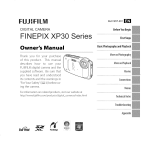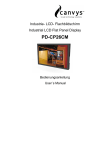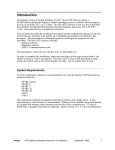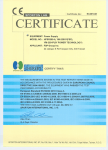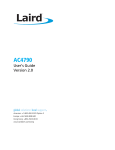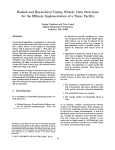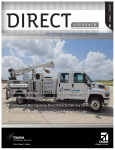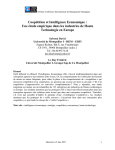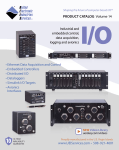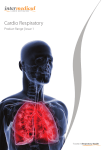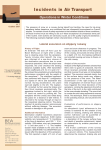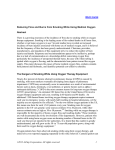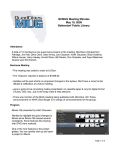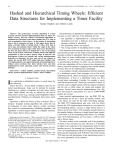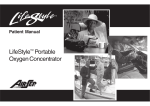Download Users of Portable Oxygen Concentrators Accept Shared
Transcript
F L I G HT S A F ETY F O U N D AT I O N CABIN CREW SAFETY Vol. 41 No. 1 For Everyone Concerned With the Safety of Flight January–February 2006 Users of Portable Oxygen Concentrators Accept Shared Responsibility for Safety Some U.S. airlines now allow passengers to operate specific portable oxygen concentrators (POCs) during all phases of flight. POC users must be familiar with their operation, including visual/aural warnings of low battery power or malfunctions. The likelihood of an in-flight medical event or a need for evacuation assistance should not be greater for POC users than for other passengers. FSF Editorial Staff Effective Aug. 11, 2005, U.S. Special Federal Aviation Regulation (SFAR) 106 permits passengers who require medical oxygen during travel on U.S. airlines to operate two specific portable oxygen concentrators (POCs) aboard aircraft during all phases of flight, provided that conditions in the regulation are met by the passenger and the airline.1 By voluntarily establishing POC programs, some U.S. airlines have enabled more people receiving oxygen therapy to travel by air. For the purposes of SFAR 106, the term portable oxygen concentrator has been defined as including two specific devices: “the AirSep LifeStyle or Inogen One … medical device units, as long as those medical device units do not contain hazardous materials as determined by [the Pipeline and Hazardous Materials Safety Administration (PHMSA) of the U.S. Department of Transportation (DOT)]; are also regulated by [the U.S. Food and Drug Administration (FDA)]; provide oxygen therapy through pulse technology;2 and assist a user of medical oxygen under a doctor’s care. The devices perform by separating oxygen from nitrogen3 and other gases contained in ambient air and dispensing it in concentrated form to the user.” Unlike conventional systems that provide a continuous flow until the bottle (tank) of compressed oxygen has been depleted, POCs provide pulses of oxygen during inhalation until the battery power has been depleted (or, if connected to an aircraft electrical power outlet, operation continues until this power has been turned off at the end of the flight and/or battery power has been resumed).4 The announcement of the SFAR 106 final rule said, “Presently, there are only two acceptable POCs on the market … and we cannot predict how future products may be developed and [may] work.” SFAR 106 applies only to air carriers that operate under U.S. Federal Aviation Regulations (FARs) Part 121, Operating Requirements: Domestic, Flag, and Supplemental Operations. “Oxygen is highly regulated because, as an oxidizer, it can enhance an existing fire, and it can support combustion of certain flammable materials, whether or not an ignition source is present,” the regulation said. “Recently, new medical oxygen technologies have been approved by the FDA that reduce the risks typically associated with compressed oxygen. … PHMSA has determined that the POCs are not hazardous materials. Thus, they do not require the same level of special handling as compressed oxygen and are safe for use [aboard] aircraft provided certain conditions for their use are met.” liquid oxygen portables — to their desired time away from home,” said Geoff Deane, Ph.D., chief technology officer for Inogen. “Because all activities of daily living can include unanticipated delays, they traditionally overestimate the amount of supplemental oxygen required. POCs enable a different type of independence — people who require oxygen therapy are never farther away from oxygen than they are from an external power supply. Air travel is a new extension of this freedom.”6 Non-U.S. Airlines Monitor Initiatives Claude Thibeault, M.D., medical adviser for the International Air Transport Association (IATA), said that POCs have not been provided or allowed by many non-U.S. airlines. One airline that currently provides POCs for passengers by advance arrangement (i.e., a medical clearance process using a medical information form completed by the passenger’s physician) is Air New Zealand, Thibeault said.7 The Inogen One portable oxygen concentrator was designed to fit under airline passenger seats. (Photo: Inogen) DOT said in a subsequent rule-making document that efforts to allow wider in-flight use of portable respiration assistive devices have resulted from consumer complaints about the absence of accommodations in air travel for passengers who use medical oxygen. “These complaints generally allege that there are a limited number of carriers that provide [medical] oxygen service (several major carriers do not); that the service, when available, is prohibitively expensive, at times exceeding the cost of air transportation; and that those passengers who need [medical] oxygen have to independently arrange with medical supply companies for additional supplies of oxygen during layovers and connections between flights,” DOT said. “As a result, many passengers with respiratory disabilities are not able to avail themselves of air transportation readily available to the general public.”5 According to POC manufacturers and organizations for people with respiratory disabilities, the advent of POCs has been revolutionary, although larger oxygen-concentration devices have been used for decades. “Before POCs, people who require oxygen therapy lived under the constant pressure of matching the estimated runtime of their supply of oxygen — typically cylinders or “Air New Zealand uses POCs as a substitute for oxygen bottles but still uses bottles for some passengers,” he said. “POCs provide a good equivalent to compressed oxygen because most airlines’ oxygen bottles are set to flow rates of either two liters per minute or four liters per minute, while a POC can be set to similar equivalent flow rates of one liter to five liters per minute of 90 percent to 95 percent oxygen. POCs are limited to a certain extent if compared with oxygen-bottle systems that can provide as much as eight liters per minute.” POCs also have been discussed among airline medical directors and medical advisers in the context of DOT rule making in late 2005 that would require airlines to test and provide various portable respiration assistive devices without charge to passengers. The proposal probably has received more international attention than SFAR 106 because more contentious and far-reaching issues are involved, Thibeault said. Passengers who carry aboard their own POCs typically would not be a significant issue for airline medical directors, Thibeault said. “They generally have a stable, chronic condition and know how to use their equipment,” he said. “We’re more concerned about acute situations in flight involving passengers with undiagnosed conditions or conditions we do not know about.” Most of the people who would use POCs in flight (e.g., those with a chronic obstructive pulmonary disease such as emphysema) are familiar with them because they use oxygen every day of their lives, he said. “Inexperience might become an issue, however, if the passenger never has used oxygen on the ground but has been prescribed oxygen for the flight,” Thibeault said. “This might occur, for example, when a traveler has suffered a heart attack while FLIGHT SAFETY FOUNDATION • CABIN CREW SAFETY • January–February 2006 abroad and then requires oxygen in flight while being repatriated without medical escort. A similar situation might be a person on the borderline of chronic lung disease who does not require oxygen on the ground but requires oxygen for air travel.” In these situations, a good option for the passenger would be to arrange for oxygen from the airline, he said. POCs Provide Automatic Alerts The user of an AirSep LifeStyle would receive visual/aural warnings if his/her breathing rate exceeded the POC capacity, the battery became depleted or the nasal cannula became dislodged and the POC could not detect respiration, said Angelo Liberatore, vice president, custom products, for AirSep Corp.8 “The AirSep LifeStyle supplies a fixed amount of oxygen, which is dependent on the flow setting and the breathing rate,” Liberatore said. “An alarm will be activated if the breathing rate is too fast for the flow-selector setting and exceeds the system capacity, but this is extremely rare for the low settings usually prescribed. The unit then will produce a lower concentration of oxygen than the unit’s specification. Several reset procedures turn off the alarm indications. For example, in the event of battery depletion, the device can be reset by inserting a fully charged battery. In the event of a POC-capacity alarm, the device will reset by the passenger’s return to the normal breathing rate. If there is a nasal cannula-disconnect alarm, the device can be reset by adjusting the cannula so that the device properly detects the user’s inspiration [inhalation].” The Inogen One provides beep sounds, light-emitting diodes that show multiple levels of alerts as flashing red lights and orange lights, and text messages relevant to the alert notification on a liquid-crystal display panel with internal illumination, Deane said. FAA Guidance to Answer Questions FAA is developing a guidance document that addresses questions and concerns that air carrier representatives and POC-user representatives raised after the SFAR 106 final rule was published, said Nancy Lauck Claussen, aviation safety inspector (cabin safety) in the FAA Certificate Management Office in Phoenix, Arizona, U.S. Because most of the U.S. airlines’ POC programs did not begin until November 2005, medical diversions of aircraft involving POC users, if any, have not been analyzed, Claussen said.9 higher concentration of oxygen than ambient air can provide); • The POC user should not expect medical oxygen to be aboard the aircraft except by advance arrangements. SFAR 106 does not imply that air carriers should carry any additional portable oxygen equipment or supplies on their aircraft because passengers have been allowed to operate POCs; • Flight attendants can anticipate that typical POC users will be well-versed in the characteristics of their own devices based on the orientation they received, a user manual and the experience of daily use in a variety of settings; • POC-related training of cabin crewmembers, while not required by SFAR 106, ideally would cover passenger briefings about decompression of the aircraft. The POC user and cabin crew must understand that the device may not meet the passenger’s oxygen needs at cabin altitudes greater than 8,000 feet to 10,000 feet. “In a decompression, the POC user should don the same drop-down oxygen masks that deploy to provide supplemental oxygen for all passengers until the flight crew descends to an altitude where the POC again can meet the oxygen need,” Claussen said. “FAA and DOT would be concerned, however, if a training program treated POC users as a special passenger category, that is, as a relatively major concern during a decompression. Cabin crews rarely know the health status of anyone walking onto the airplane, so it would be inconsistent with DOT Part 382, Nondiscrimination on the Basis of Disability in Air Travel, to single out an individual with a respiratory disability except for a specific safety reason. After all, a passenger who does not use a POC might be the one who actually needs supplemental oxygen after a decompression”; • Under the principles of DOT Part 382, flight attendants also should be trained to consider the needs and abilities of POC users based on objective criteria rather than general assumptions. “Cabin crewmembers would be expected to assess a POC user as they would assess any other passenger in terms of a possible role as an able-bodied assistant during evacuation or as someone requiring assistance during evacuation,” Claussen said; The context of SFAR 106 includes the following assumptions and elements, she said: • Training for smoke/fire/fumes events likely would not require modification because of the POC program. “All crewmembers’ current training to use portable oxygendispensing equipment in emergency situations would apply,” Claussen said; and, • POCs are considered life-enhancing devices, not lifesustaining devices (i.e., the user normally can breathe without the POC for some period but benefits from a • A draft FAA guidance document 10 for air carriers developing POC programs recommends that, for the POC to work effectively in the aircraft cabin, the passenger FLIGHT SAFETY FOUNDATION • CABIN CREW SAFETY • January–February 2006 AirSep LifeStyle units manufactured before the RTCA/DO– 160D standard was applied to POCs can be tested by an airline using a test protocol provided in an FAA advisory circular for portable electronic devices aboard civil aircraft.12 If examples of these AirSep LifeStyle units pass testing by the airline, the airline can tell its crewmembers that any generation of AirSep LifeStyle will be allowed to be operated in flight. In practice, most air carriers have decided to allow the use of both manufacturers’ POCs to the extent possible, according to FAA. FAA also has provided information to air carriers about how to determine the dimensions and weights of the POCs covered by the SFAR for use in reviewing carry-on baggage programs to determine whether they require modification and whether POCs can be stowed properly on specific aircraft.13 Pilot-in-command Must Be Notified The AirSep LifeStyle portable oxygen concentrator was introduced in June 2002. (Photo: AirSep Corp.) should ensure that its air-intake filter is not blocked during use, Claussen said. The POC also should be oriented so that the user or the passenger assisting the POC user can observe warning lights and/or hear aural warnings if there is a low-battery alert or a malfunction. “Positioning the device directly under the POC user’s seat might prohibit the individual from seeing warning lights, and stowing the device in a closed compartment may prohibit the person from hearing the aural warnings,” she said. The requirement to notify the pilot-in-command usually can be accomplished by modifying an existing communication procedure, Claussen said. The flight deck crew’s awareness of in-flight use of a POC has several safety benefits. Specific responsibilities for compliance with the provisions of SFAR 106 are assigned to the POC manufacturer and/or airline, the POC user, the pilot-in-command and the cabin crew. “It is necessary for the pilot-in-command to know this information because of the possibility the device will fail, and the user may have a medical emergency requiring emergency action on the part of the flight crew,” FAA said. “Also, if a POC is using the electrical power of the aircraft as its main power source, the pilot will benefit from the knowledge and be able to announce and inform users if the use of that power needs to be restricted during the flight.” POC Must Not Interfere With Systems Document Assists Cabin Crew SFAR 106 says, “[Air carriers must ensure that] the device does not cause interference with the electrical, navigation or communication equipment on the aircraft on which the device is to be used.” SFAR 106 says, “The user must have a written statement, to be kept in that person’s possession, signed by a licensed physician that states whether the user of the device has the physical and cognitive ability to see, hear and understand the device’s aural and visual cautions and warnings and is able, without assistance, to take the appropriate action in response to those cautions and warnings; states whether or not oxygen use is medically necessary for all or a portion of the duration of the trip; and specifies the maximum oxygen flow rate corresponding to the pressure in the cabin of the aircraft under normal operating conditions.” According to FAA’s draft guidance for airlines, the POC manufacturer’s third-party documentation that a device has complied with the standard of RTCA/DO–160D, Environmental Conditions and Test Procedures for Airborne Equipment, Section 21, Category M (classified as a medical portable electronic device) 11 is acceptable to FAA; this provision applies to all Inogen One units and to all AirSep LifeStyle units manufactured after August 2005. Under the second provision, SFAR 106 says, “The pilot-in-command must be apprised whenever a passenger brings and intends to use a [POC aboard] the aircraft, and the pilot-in-command must be informed about the contents of the physician’s written statement … including the magnitude and nature of the passenger’s oxygen needs.” The regulation also says, “The user must inform the aircraft operator that he or she intends to use a [POC aboard] the aircraft FLIGHT SAFETY FOUNDATION • CABIN CREW SAFETY • January–February 2006 and must allow the crew of the aircraft to review the contents of the physician’s statement.” • “Only lotions or salves that are oxygen-approved may be used by persons using the [POC] device.” Based on the physician’s statement, the cabin crew will know whether the POC will be operated during movement on the surface, takeoff and landing, whether a seating restriction for the POC user is appropriate or whether the POC should be stowed (e.g., device kept with spare batteries within reach under the passenger seat in front of the user) so that the device does not block access to the aisle. All these precautions should be familiar to POC users because of their training, Claussen said. FAA said, “In either case, POCs and the extra batteries needed to power them must be properly stowed in accordance with the applicable carry-on baggage requirements.”14 POC User Takes Responsibility SFAR 106 says, “The user must be capable of hearing the unit’s alarms, seeing the alarm light indicators, and have the cognitive ability to take the appropriate action in response to the various caution and warning alarms and alarm light indicators, or be traveling with someone who is capable of performing those functions.” The cabin crew helps provide a safe environment for the passenger to operate the POC. “Responsibility for the condition of the device, sufficient battery power, safe use, etc., sits squarely on the shoulders of the POC user,” Claussen said. FAA said, “We … encourage passengers who have a medical need for lengthy periods of oxygen use to ensure that [medical oxygen] equipment is available before arranging for a flight. … In case of aircraft electrical power [failure] or battery failure, [an appropriate action by cabin crew] would be to refer to the passenger’s physician statement and consult with the passenger using the POC. The crewmember should determine … the person’s medical need for oxygen use and provide access to the aircraft’s first-aid oxygen equipment if necessary.” Device Must Be Operated Safely SFAR 106 says that the POC user’s operation of the device requires attention to the following oxygen-specific safety issues: • “The user must ensure that the [POC] is free of oil, grease or other petroleum products and is in good condition, free from damage or other signs of excessive wear or abuse”; • “No smoking or open flame is permitted within 10.0 feet [3.0 meters] of any seat row where a person is using a [POC]”; and, POC Users Know Battery Limits SFAR 106 says, “The user, whose physician statement specifies the duration of oxygen use, must obtain from the aircraft operator, or by other means, the duration of the planned flight. The user must carry on the flight a sufficient number of batteries to power the device for the duration of the oxygen use specified in the user’s physician statement, including a conservative estimate of any unanticipated delays.” FAA expects the physician to make recommendations about preparing for contingencies such as in-flight delays and ground delays. The manufacturer’s user manual shows typical battery life for the prescribed liters per minute of equivalent oxygen flow. The number of spare batteries that should be carried then can be estimated by the POC user. “If airline passengers have difficulty in making the determination of how many spare batteries to carry, they should seek the support of their physician or medical equipment provider,” said Deane. “As an example, using flow setting 2 [two liters per minute] on the Inogen One may provide three hours of operation per battery. For a five-hour flight at this setting, the typical passenger might consider carrying enough batteries for at least seven hours of operation (i.e., three batteries). Patients should ensure that batteries are fully charged before beginning their travel.” POCs are designed to operate on electrical power from internal batteries and/or external batteries, but they also can be plugged into other power sources. The AirSep LifeStyle has rechargeable batteries of the nickel-metal-hydride type; one fully charged, internal battery operates the device for a maximum of about 50 minutes of normal use. If a fully charged, three-battery power pack also has been attached, the four batteries combined operate the device for a maximum of about three hours and 15 minutes. The Inogen One uses rechargeable batteries of the lithium-ion type. One fully charged, internal battery operates the device for a maximum of about three hours of normal use. A battery can remain inside the AirSep LifeStyle while using aircraft power, Liberatore said. The battery must be removed from the Inogen One while using aircraft power, Deane said. Other external power sources for either POC might include a wall outlet in an airport waiting area or a cabin power outlet, if approved by FAA and designated by the airline. FAA also said, “If the aircraft electrical system is available to recharge a POC battery, it is currently permissible to do so under this SFAR.” The optional external power packs of some POCs can FLIGHT SAFETY FOUNDATION • CABIN CREW SAFETY • January–February 2006 be recharged separately from the POC using an aircraft power outlet. The power outlets on many transport jets were not designed explicitly for passenger use in flight. “Except when the airline provides power outlets designed for passengers’ portable electronic devices, the only outlets typically are located near galleys, flight attendant jump seats and high-traffic areas used while the aircraft is parked on the ground — not for a POC power cord to be extended safely or conveniently to a passenger’s seat,” Claussen said. “POC power sources were the point of greatest concern for FAA, and the design, packaging and carriage of spare batteries and optional battery packs also were a major safety issue to address.” A situation involving the depletion of all available POC batteries, absence of aircraft electrical power for the POC or alarms indicating malfunction of the POC during flight should be assessed as a possible in-flight medical event, she said. If the situation becomes a medical event, the cabin crewmember’s focus of attention should be the passenger — without allowing the visual alarms and aural alarms on the POC to distract them. “Some airlines that have developed POC-related training teach flight attendants that if anything goes wrong with the POC, ‘Do not worry about the POC, pretend that the POC is not there and take care of the passenger,’” Claussen said. “In a practical sense, most air carriers do carry extra portable oxygen bottles to respond to medical events, and cabin crews have extensive training for these situations. The medical oxygen available can be used to respond to a POC user as to any other passenger who is having a heart attack, having trouble breathing or in another situation where providing oxygen would be appropriate.” Spare Batteries Must Be Protected SFAR 106 says, “The user must ensure that all [POC] batteries carried [aboard] the aircraft in carry-on baggage are protected from short circuit and are packaged in a manner that protects them from physical damage. Batteries protected from short circuit include those designed with recessed battery terminals; or those packaged so that the battery terminals do not contact metal objects (including the battery terminals of other batteries).” Compliance with FARs reduces the risk that any type of loose battery in carry-on baggage could ignite a fire. “Although most battery-pack manufacturers employ various protective devices to prevent abuse, such as thermal or pressure disconnects and shutdown separators to prevent battery overheating and fires, abuse conditions such as physical damage to the cell(s) or external short circuits do occur,” FAA said. “Abuse of the battery can cause those safeguards to become ineffective unless other protective measures, such as battery outer protective packaging, are used. … Protection from shortcircuit problems may be provided by batteries designed with recessed battery terminals or by packaging that keeps the battery terminals from contacting metal objects (including the battery terminals of other batteries).” Inogen One batteries require no special packaging because safety measures required by SFAR 106 have been incorporated into the battery’s design, Deane said. AirSep makes a sparebattery bag for POC users to securely carry and keep in protected compartments from one battery to six batteries for the AirSep LifeStyle, Liberatore said. Stowed POCs Require Precautions SFAR 106 says, “When a battery-powered [POC] is carried [aboard] aircraft as carry-on baggage and is not intended to be used during the flight, the battery must be removed and packaged separately unless the [POC] contains at least two effective protective features [i.e., design features that shield the POC from inadvertent contact or several operating procedures that require specific deliberate actions to turn on the POC] to prevent accidental operation during transport.” The requirement to remove batteries was developed by FAA as a method “to prevent inadvertent operation of the POC, which could result in a battery overheating and/or fire,” Claussen said. When the Inogen One is not in use during flight, it should be stowed with the battery and external power supplies removed, Deane said. Otherwise, to prevent accidental actuation of the device, a handle partially shields the user interface panel from accidental contact, a prolonged press of the on/off button is required and a series of visual/aural alerts occur during start-up. “Our device poses no oxygen-related hazard, as it does not emit any concentrated oxygen without the user triggering a pulse of oxygen while breathing from the attached nasal cannula, and it contains multiple internal sensors and automatic shut-offs to prevent overheating,” Deane said. “The device does not need to be turned off when not in use in a seat, as the device will not emit any concentrated oxygen in the absence of breath detection. In this case, unused purified oxygen within the device is recombined with effluent nitrogen and is emitted as exhaust.” Two protective features to prevent accidental operation of the AirSep LifeStyle during transport are a protective cover over all controls and a rotary flow-selector knob that requires a deliberate action to move, said Liberatore. Exit Rows Off Limits to POC Users SFAR 106 says, “No person using a [POC] is permitted to sit in an exit row.” Aside from this restriction, however, where and how to safely seat POC users in the aircraft cabin was a significant subject of discussion during rule making. FLIGHT SAFETY FOUNDATION • CABIN CREW SAFETY • January–February 2006 “The question raised was whether crewmembers could assume that passengers who fit the ‘POC user’ demographic might move more slowly than other passengers or might impede the evacuation — leading to assignment of a window seat,” Claussen said. “FAA’s response is that it is not appropriate to restrict seating solely based on the fact that passengers identify themselves as a POC user intending to operate the device in flight. A valid safety reason to impose a case-by-case seating restriction would be if the passenger is operating the POC during certain phases of flight so that the oxygen tube or the power cord stretches across a seat row, blocks egress by other passengers or becomes a tripping hazard in an evacuation.” POC Must Not Block Evacuation SFAR 106 says, “During movement on the surface, takeoff and landing, the unit must either be stowed under the seat in front of the user or in another approved stowage location, so that it does not block the aisle way or the entryway into the row; or if it is to be operated by the user, be used only at a seat location that does not restrict any passenger’s access to, or use of, any required emergency or regular exit, or the aisle(s) in the passenger compartment.” Flight attendants must comply with applicable safety regulations when the passenger’s physician statement indicates that the POC will be operated during movement on the surface, takeoff and landing, Claussen said. “Another valid individual circumstance for restricting seating could be that some seats do not have approved stowage space to accommodate the POC during ground movement, takeoff and landing,” she said. Normal Cabin Movement Is Approved SFAR 106 says, “Whenever the pilot-in-command turns off the ‘FASTEN SEAT BELT’ sign or otherwise signifies that permission is granted to move about the passenger cabin, passengers operating their [POC] may continue to operate it while moving about the cabin.” Passengers may walk around the cabin while carrying the POC anytime other passengers are free to move about the cabin, Claussen said. In practice, the POC user could carry the device by a handle or strap, or use a rolling cart holding the POC and an external power pack. DOT Proposes Airline Requirements In announcing the SFAR 106 final rule, FAA said that the agency currently does not have the statutory authority under DOT Part 382 to require air carriers to allow POCs to be carried or operated aboard their aircraft. DOT in 2005 issued a notice of proposed rule making (NPRM) that would make it possible for FAA to add requirements for air carriers to provide medical oxygen and portable respiration assistive devices such as POCs, portable liquid oxygen units, safety-sealed compressed oxygen, ventilators, respirators and continuous positive airway pressure machines. “[DOT] proposes to amend its rules implementing the Air Carrier Access Act … to provide greater accommodations in air travel for persons with respiratory disabilities,” the NPRM said. “This [NPRM] applies to U.S. air carriers and foreign air carriers operating flights in, to and from the United States. … The proposed rule establishes procedures within applicable U.S. and foreign safety rules for the carriage and use of portable respiration-related assistive devices and medical oxygen devices aboard commercial flights by passengers with disabilities. … As a corollary to the FAA rulemaking on allowing the use of certain [POCs], [DOT] is now proposing a rulemaking to address the treatment of [POCs] as an assistive device in air travel.”♦ Notes 1. U.S. Federal Aviation Administration (FAA). U.S. Federal Aviation Regulations (FARs) Part 11 [General Rulemaking Procedures] and Part 121 [Operating Requirements: Domestic, Flag, and Supplemental Operations], Use of Certain Portable Oxygen Concentrator [POC] Devices Onboard Aircraft; Final Rule. Federal Register Part III, July 12, 2005. 2. AirSep Corp. Patient Manual: AirSep LifeStyle Portable Oxygen Concentrator. December 2004. The user manual said that the POC continuously produces oxygen, but a small volume of oxygen (called a pulse dose) is delivered through tubing to the nasal cannula only when the user begins to inhale. 3. Reynolds, Thomas L. “Gas Separation Technology: State of the Art.” A paper presented to the Halon Options Technical Working Conference, April 24–26, 2001, in Albuquerque, New Mexico, U.S. Thomas represented Boeing Seattle Phantom Works, the advanced research and development unit of The Boeing Co. In Special Federal Aviation Regulation 106, “separating oxygen from nitrogen” and “filtering out nitrogen from the air” refer to the pressure-swingadsorption process in which nitrogen from compressed air is adsorbed by synthetic-zeolite molecular sieves (i.e., nitrogen molecules concentrate in the pores of zeolite powder/pellets in a canister while oxygen molecules pass through the canister). When a molecular sieve becomes saturated with nitrogen, devices such as POCs redirect airflow through a different molecular sieve so that alternating cycles of adsorption and purging continuously produce oxygen. 4. FAA said, “The FAA agrees that if aircraft operators obtain FAA authorization, access to the electrical power supply of the aircraft can be made available for a POC user, but it is not requiring the operator to inform the passenger about the availability of electrical outlets. … If carriers wish to provide such information to potential POC users, it is their choice to do so. … If, for example, an operator of a transport category airplane provides a passenger access to aircraft electrical power for use with a POC, the operator must ensure that the installation and cabling, up to the point where the passenger plugs in the POC, meets the airworthiness standards of [FARs Parts] 25.1301, 25.1309, 25.1353 and 25.1357. … These sections ensure FLIGHT SAFETY FOUNDATION • CABIN CREW SAFETY • January–February 2006 that the wiring and circuit protection are sufficient for the intended use. The sections also ensure that the POC will not negatively affect aircraft power.” 5. U.S. Department of Transportation (DOT). Notice of Proposed Rulemaking. DOT Regulations Part 382, Nondiscrimination on the Basis of Disability in Air Travel — Medical Oxygen and Portable Respiration Assistive Devices. Federal Register, Volume 70, Sept. 7, 2005. 6. Deane, Geoff. E-mail communication with Rosenkrans, Wayne. Alexandria, Virginia, U.S. Jan. 13, 2006. Flight Safety Foundation, Alexandria, Virginia, U.S. 7. Thibeault, Claude. Telephone interview by Rosenkrans, Wayne. Alexandria, Virginia, U.S. Jan. 16, 2006. Flight Safety Foundation, Alexandria, Virginia, U.S. <www.airnz.co.nz> The Air New Zealand Internet site said, “If you are traveling both internationally and domestically with Air New Zealand as part of the same journey on the same day, Air New Zealand will provide the oxygen at an additional cost from either portable cylinders [bottles] or a specially designed aircraft oxygen concentrator.” 8. Liberatore, Angelo J. E-mail communication with Rosenkrans, Wayne. Alexandria, Virginia, U.S. Jan. 16, 2006. Flight Safety Foundation, Alexandria, Virginia, U.S. 9. Claussen, Nancy Lauck. Telephone interview by Rosenkrans, Wayne. Alexandria, Virginia, U.S. Jan. 13, 2006. Flight Safety Foundation, Alexandria, Virginia, U.S. FAA expects to release in early 2006 a Joint Flight Standards Information Bulletin for Air Transportation (FSAT) and Airworthiness (FSAW). 10. Claussen referred to the pending FSAT/FSAW. 11. RTCA formerly was called the Radio Technical Commission for Aeronautics. 12. FAA Advisory Circular 91.21–1A, Use of Portable Electronic Devices Aboard Aircraft. Oct. 2, 2000. 13. FAA. Notice N 8000.304, Portable Oxygen Concentrators. Aug. 18, 2005. The notice said, “Some aircraft operators may be hesitant to allow POC users to carry POCs on board and operate them because of concerns regarding adequate POC stowage space on certain aircraft whose carry-on baggage stowage space is limited and whose under-seat stowage area may not accommodate these POCs and other carry-on items.” <www.airsep.com> The manufacturer said that the AirSep LifeStyle weighs 9.75 pounds (4.42 kilograms) and its dimensions are 5.50 inches (13.97 centimeters) high by 7.25 inches (18.42 centimeters) wide by 16.31 inches (41.43 centimeters) long. <www.inogen.net> The manufacturer said that the Inogen One weighs 9.7 pounds (4.4 kilograms) and its dimensions are 12.39 inches (31.47 centimeters) high by 6.00 inches (15.24 centimeters) wide by 11.62 inches (29.51 centimeters) long. 14. Applicable carry-on baggage requirements for air carrier operations are in FARs Parts 91.523, 91.525, 121.285 and 121.589. Further Reading From FSF Publications FSF Editorial Staff. “Current Procedures Maintain Safety During Medical Use of Oxygen.” Cabin Crew Safety Volume 36 (July–August 2001). Want more information about Flight Safety Foundation? Contact Ann Hill, director, membership and development, by e-mail: [email protected] or by telephone: +1 (703) 739-6700, ext. 105. Visit our Internet site at <www.flightsafety.org>. We Encourage Reprints Articles in this publication, in the interest of aviation safety, may be reprinted, in whole or in part, but may not be offered for sale, used commercially or distributed electronically on the Internet or on any other electronic media without the express written permission of Flight Safety Foundation’s director of publications. All uses must credit Flight Safety Foundation, Cabin Crew Safety, the specific article(s) and the author(s). Please send two copies of the reprinted material to the director of publications. These restrictions apply to all Flight Safety Foundation publications. Reprints must be ordered from the Foundation. What’s Your Input? In keeping with the Foundation’s independent and nonpartisan mission to disseminate objective safety information, FSF publications solicit credible contributions that foster thought-provoking discussion of aviation safety issues. If you have an article proposal, a completed manuscript or a technical paper that may be appropriate for Cabin Crew Safety, please contact the director of publications. Reasonable care will be taken in handling a manuscript, but Flight Safety Foundation assumes no responsibility for material submitted. The publications staff reserves the right to edit all published submissions. The Foundation buys all rights to manuscripts and payment is made to authors upon publication. Contact the Publications Department for more information. Cabin Crew Safety Copyright © 2006 by Flight Safety Foundation Inc. All rights reserved. ISSN 1057-5553 Suggestions and opinions expressed in FSF publications belong to the author(s) and are not necessarily endorsed by Flight Safety Foundation. This information is not intended to supersede operators’/manufacturers’ policies, practices or requirements, or to supersede government regulations. Staff: Mark Lacagnina, senior editor; Wayne Rosenkrans, senior editor; Linda Werfelman, senior editor; Rick Darby, associate editor; Karen K. Ehrlich, web and print production coordinator; Ann L. Mullikin, production designer; Susan D. Reed, production specialist; and Patricia Setze, librarian, Jerry Lederer Aviation Safety Library Subscriptions: One year subscription for six issues includes postage and handling: US$160 for members/US$280 for nonmembers. Include old and new addresses when requesting address change. • Attention: Ahlam Wahdan, membership services coordinator, Flight Safety Foundation, Suite 300, 601 Madison Street, Alexandria, VA 22314 U.S. • Telephone: +1 (703) 739-6700 • Fax: +1 (703) 739-6708. FLIGHT SAFETY FOUNDATION • CABIN CREW SAFETY • January–February 2006








